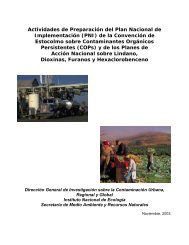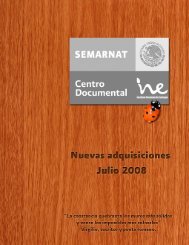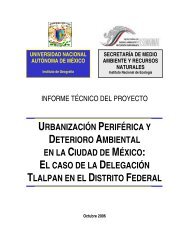Agroecosistemas cafetaleros de Veracruz - Instituto Nacional de ...
Agroecosistemas cafetaleros de Veracruz - Instituto Nacional de ...
Agroecosistemas cafetaleros de Veracruz - Instituto Nacional de ...
You also want an ePaper? Increase the reach of your titles
YUMPU automatically turns print PDFs into web optimized ePapers that Google loves.
Capítulo 1Estudios <strong>de</strong> la biodiversida<strong>de</strong>n cafetalesRobert H. Manson, Armando Contreras Hernán<strong>de</strong>zy Fabiola López-BarreraResumenEn este capítulo se resalta la importancia <strong>de</strong> la cafeticultura en la conservación <strong>de</strong> la biodiversidad <strong>de</strong> México,país megadiverso, así como en mantener el bienestar socio-económico <strong>de</strong> una proporción significativa <strong>de</strong> lapoblación rural. Asimismo, se señalan los retos que enfrentan los productores <strong>de</strong> café en la aplicación <strong>de</strong>las prácticas convencionales <strong>de</strong> producción y la búsqueda <strong>de</strong> estrategias <strong>de</strong> manejo sustentables a través<strong>de</strong> los conceptos y métodos <strong>de</strong> la ciencia agroecológica. Aplicando un enfoque interdisciplinario, multitaxonómicoy participativo, el proyecto buscó superar los sesgos implícitos en los estudios científicos <strong>de</strong>estos agroecosistemas, que hasta la fecha han limitado sus contribuciones. Se evaluaron la biodiversidad(12 grupos <strong>de</strong> plantas y animales), los servicios ambientales (secuestro <strong>de</strong> carbono, fertilidad <strong>de</strong>l suelo,captación <strong>de</strong> agua y polinización), las estrategias <strong>de</strong> manejo y el contexto socio-económico <strong>de</strong> fincas <strong>de</strong>café en el centro <strong>de</strong>l estado <strong>de</strong> <strong>Veracruz</strong>, utilizando 18 fincas y tres fragmentos <strong>de</strong> bosque como sitios <strong>de</strong>estudio <strong>de</strong> largo plazo. El proyecto convocó a tres organizaciones <strong>de</strong> cafeticultores <strong>de</strong>l centro <strong>de</strong>l estado<strong>de</strong> <strong>Veracruz</strong>, México, para divulgar sus resultados y, junto con ellos, generar información relevante para: 1)caracterizar las estrategias <strong>de</strong> manejo <strong>de</strong>l café <strong>de</strong> la región, 2) evaluar su impacto sobre la biodiversidad, losservicios ambientales y la productividad en cada finca, 3) i<strong>de</strong>ntificar recursos <strong>de</strong> uso potencial y 4) elaborarpropuestas <strong>de</strong> política pública que permitan un <strong>de</strong>sarrollo con equidad.AbstractThis chapter reviews the arguments regarding the importance of sha<strong>de</strong> coffee production in conservingof the biodiversity of mega-diverse México, as well as in maintaining the socio-economic wellbeing ofan important segment of the population. In addition, we highlight some of the challenges facing coffeegrowers using conventional production strategies or interested in pursuing more sustainable managementpractices <strong>de</strong>veloped from the science of agroecology. Using an interdisciplinary, multi-taxonomic and participativeapproach we <strong>de</strong>signed a project that sought to overcome some of the main biases present instudies of coffee agroecosystems and that have limited their impact to date. The biodiversity (12 groupsof plants and animals), ecosystem services (including carbon sequestration, soil fertility and water capture,and pollination), management strategies, and the socio-economic context of coffee farms in central<strong>Veracruz</strong>, Mexico, were evaluated using 18 coffee farms and three forest fragments treated as long-termstudy sites. The project worked with three groups of coffee growers in this region to transmit the mainfindings of this research regarding the characterization of coffee management strategies, the evaluationof their impacts on the structure and function of coffee farms, the i<strong>de</strong>ntification of alternative revenuesources, and the <strong>de</strong>velopment of public programs that promote equitable <strong>de</strong>velopment.






